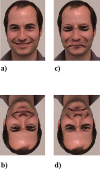Is the Thatcher Illusion Modulated by Face Familiarity? Evidence from an Eye Tracking Study
- PMID: 27776145
- PMCID: PMC5077119
- DOI: 10.1371/journal.pone.0163933
Is the Thatcher Illusion Modulated by Face Familiarity? Evidence from an Eye Tracking Study
Abstract
Thompson (1980) first detected and described the Thatcher Illusion, where participants instantly perceive an upright face with inverted eyes and mouth as grotesque, but fail to do so when the same face is inverted. One prominent but controversial explanation is that the processing of configural information is disrupted in inverted faces. Studies investigating the Thatcher Illusion either used famous faces or non-famous faces. Highly familiar faces were often thought to be processed in a pronounced configural mode, so they seem ideal candidates to be tested in one Thatcher study against unfamiliar faces-but this has never been addressed so far. In our study, participants evaluated 16 famous and 16 non-famous faces for their grotesqueness. We tested whether familiarity (famous/non-famous faces) modulates reaction times, correctness of grotesqueness assessments (accuracy), and eye movement patterns for the factors orientation (upright/inverted) and Thatcherisation (Thatcherised/non-Thatcherised). On a behavioural level, familiarity effects were only observable via face inversion (higher accuracy and sensitivity for famous compared to non-famous faces) but not via Thatcherisation. Regarding eye movements, however, Thatcherisation influenced the scanning of famous and non-famous faces, for instance, in scanning the mouth region of the presented faces (higher number, duration and dwell time of fixations for famous compared to non-famous faces if Thatcherised). Altogether, famous faces seem to be processed in a more elaborate, more expertise-based way than non-famous faces, whereas non-famous, inverted faces seem to cause difficulties in accurate and sensitive processing. Results are further discussed in the face of existing studies of familiar vs. unfamiliar face processing.
Conflict of interest statement
The authors have declared that no competing interests exist.
Figures






Similar articles
-
An examination of the processing capacity of features in the Thatcher illusion.Atten Percept Psychophys. 2012 Oct;74(7):1475-87. doi: 10.3758/s13414-012-0330-z. Atten Percept Psychophys. 2012. PMID: 22707354
-
The role of configurality in the Thatcher illusion: an ERP study.Psychon Bull Rev. 2015 Apr;22(2):445-52. doi: 10.3758/s13423-014-0705-3. Psychon Bull Rev. 2015. PMID: 25102929 Free PMC article.
-
Faces as objects of non-expertise: processing of thatcherised faces in congenital prosopagnosia.Perception. 2007;36(11):1635-45. doi: 10.1068/p5467. Perception. 2007. PMID: 18265844
-
What's lost in inverted faces?Cognition. 1993 Apr;47(1):25-57. doi: 10.1016/0010-0277(93)90061-y. Cognition. 1993. PMID: 8482070 Review.
-
On the particular vulnerability of face recognition to aging: a review of three hypotheses.Front Psychol. 2015 Aug 21;6:1139. doi: 10.3389/fpsyg.2015.01139. eCollection 2015. Front Psychol. 2015. PMID: 26347670 Free PMC article. Review.
References
-
- Thompson P. Margaret Thatcher: A new illusion. Perception. 1980; 9: 483–484. - PubMed
-
- Bertin E, & Bhatt RS. The Thatcher illusion and face processing in infancy. Dev Sci. 2004; 7: 431–436. - PubMed
-
- Carbon CC, & Leder H. When feature information comes first! Early processing of inverted faces. Perception. 2005; 34: 1117–1134. - PubMed
-
- Carbon CC, Schweinberger SR, Kaufmann JM, & Leder H. The Thatcher illusion seen by the brain: an event-related brain potentials study. Cognitive Brain Res. 2005; 24: 544–555. - PubMed
-
- Lewis MB. The Lady's not for turning: Rotation of the Thatcher illusion. Perception. 2001; 30: 769–774. - PubMed
MeSH terms
LinkOut - more resources
Full Text Sources
Other Literature Sources

